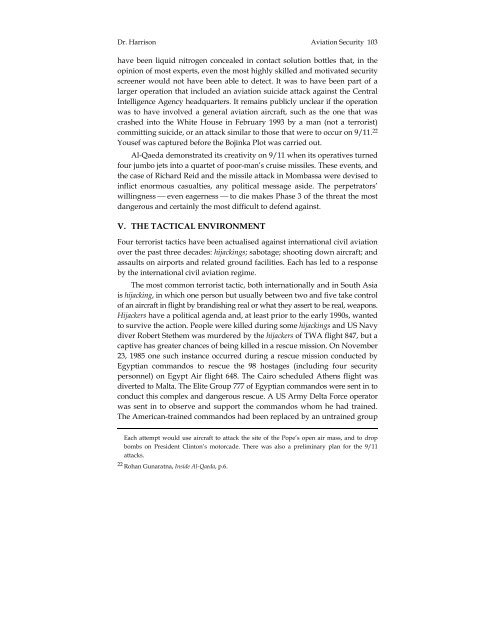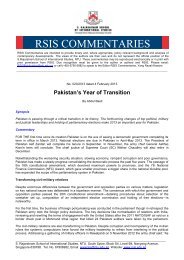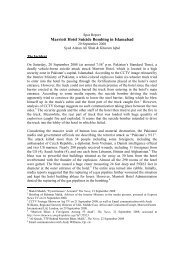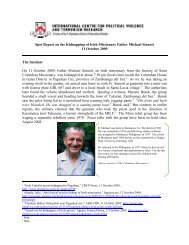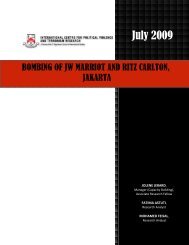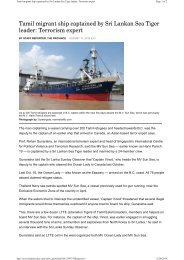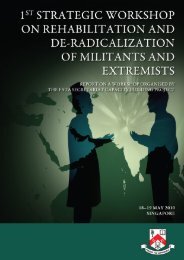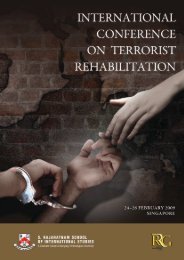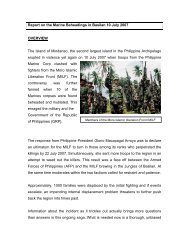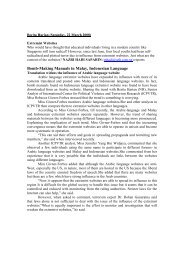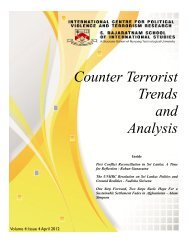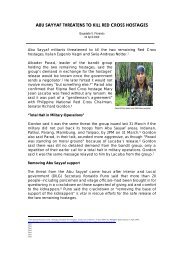Peace and Security Review, Vol.1 No. 2 - International Centre for ...
Peace and Security Review, Vol.1 No. 2 - International Centre for ...
Peace and Security Review, Vol.1 No. 2 - International Centre for ...
You also want an ePaper? Increase the reach of your titles
YUMPU automatically turns print PDFs into web optimized ePapers that Google loves.
Dr. Harrison Aviation <strong>Security</strong> 103<br />
have been liquid nitrogen concealed in contact solution bottles that, in the<br />
opinion of most experts, even the most highly skilled <strong>and</strong> motivated security<br />
screener would not have been able to detect. It was to have been part of a<br />
larger operation that included an aviation suicide attack against the Central<br />
Intelligence Agency headquarters. It remains publicly unclear if the operation<br />
was to have involved a general aviation aircraft, such as the one that was<br />
crashed into the White House in February 1993 by a man (not a terrorist)<br />
committing suicide, or an attack similar to those that were to occur on 9/11. 22<br />
Yousef was captured be<strong>for</strong>e the Bojinka Plot was carried out.<br />
Al-Qaeda demonstrated its creativity on 9/11 when its operatives turned<br />
four jumbo jets into a quartet of poor-man’s cruise missiles. These events, <strong>and</strong><br />
the case of Richard Reid <strong>and</strong> the missile attack in Mombassa were devised to<br />
inflict enormous casualties, any political message aside. The perpetrators’<br />
willingness ⎯ even eagerness ⎯ to die makes Phase 3 of the threat the most<br />
dangerous <strong>and</strong> certainly the most difficult to defend against.<br />
V. THE TACTICAL ENVIRONMENT<br />
Four terrorist tactics have been actualised against international civil aviation<br />
over the past three decades: hijackings; sabotage; shooting down aircraft; <strong>and</strong><br />
assaults on airports <strong>and</strong> related ground facilities. Each has led to a response<br />
by the international civil aviation regime.<br />
The most common terrorist tactic, both internationally <strong>and</strong> in South Asia<br />
is hijacking, in which one person but usually between two <strong>and</strong> five take control<br />
of an aircraft in flight by br<strong>and</strong>ishing real or what they assert to be real, weapons.<br />
Hijackers have a political agenda <strong>and</strong>, at least prior to the early 1990s, wanted<br />
to survive the action. People were killed during some hijackings <strong>and</strong> US Navy<br />
diver Robert Stethem was murdered by the hijackers of TWA flight 847, but a<br />
captive has greater chances of being killed in a rescue mission. On <strong>No</strong>vember<br />
23, 1985 one such instance occurred during a rescue mission conducted by<br />
Egyptian comm<strong>and</strong>os to rescue the 98 hostages (including four security<br />
personnel) on Egypt Air flight 648. The Cairo scheduled Athens flight was<br />
diverted to Malta. The Elite Group 777 of Egyptian comm<strong>and</strong>os were sent in to<br />
conduct this complex <strong>and</strong> dangerous rescue. A US Army Delta Force operator<br />
was sent in to observe <strong>and</strong> support the comm<strong>and</strong>os whom he had trained.<br />
The American-trained comm<strong>and</strong>os had been replaced by an untrained group<br />
Each attempt would use aircraft to attack the site of the Pope’s open air mass, <strong>and</strong> to drop<br />
bombs on President Clinton’s motorcade. There was also a preliminary plan <strong>for</strong> the 9/11<br />
attacks.<br />
22 Rohan Gunaratna, Inside Al-Qaeda, p.6.<br />
<strong>Vol.1</strong>, <strong>No</strong>.2 2008 pp.95-114


